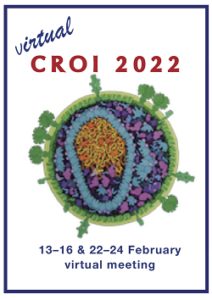CROI 2022: UK study shows PEP is started earlier using home starter packs
1 April 2022. Related: Conference reports, HIV prevention and transmission, CROI 29 (Retrovirus) 2022.
Simon Collins, HIV i-Base
 A UK study reported benefits from having 5-day starter packs of PEP at home for people at risk of HIV that included a significantly shorter time to starting PEP – the most important factor for PEP efficacy.
A UK study reported benefits from having 5-day starter packs of PEP at home for people at risk of HIV that included a significantly shorter time to starting PEP – the most important factor for PEP efficacy.
During 2018/19, the phase 4 HOME PEP study randomised 139 gay men (1:1) to either immediate access to starter packs (once-daily maraviroc plus TDF/FTC) for 48 weeks or to current standard of care, with access to starter packs for six months after week 48.
The study enrolled mainly youngish gay men who were sexually active, at risk of HIV and engaged in care.
Baseline characteristics included median age 30 (IQR: 26 to 39); 70% White, 9% Black/African; 72% University education; 72% full-time work, 7% part-time, 15% college; 55% born in the UK and 65% currently single.
More than half (56%) had an STI diagnosis in the previous 12 months, with one-third rectal. Most people had several HIV tests in the previous year (median 3; IQR 2 to 4) and 39% had previously used PEP.
If PEP was started, based on a self-completed risk questionnaire, the decision to continue was decided by a doctor. The most common use (81% cases) was due to receptive anal sex with a man of unknown HIV status. Risk and quality of life questionnaires were completed by all participants every three months.
Based on results for the first 48 weeks, access to starter packs meant that PEP was used more often (in 22 vs 13 cases). This did not lead to inappropriate use as 29/33 cases of PEP use would otherwise have been indicated (88%, 95% CI: 73 to 95%).
The home packs significantly reduced the median time to first dose: 7.6 hours (IQR: 3.0 to 20.9; n=22) vs 28.5 hours (IQR: 17.3 to 34; n=13), p<0.01. PEP was used more than once by 6 vs 2 people in the immediate vs deferred arm, respectively.
Most participants using PEP in the immediate arm started PEP straight after sex (n=10), with 4 and 6 cases starting before 10 and 20 hours respectively. One person in each arm didn’t start PEP until after 48 hours (perhaps because risks don’t always occur at home).
Access to the packs did not change risk behaviour during the study, with risks remaining similar in each arm to the three months before the study (512 vs 911 in the immediate vs deferred groups respectively, p = 0.215).
Although the immediate group had almost half the number of missed chances to use PEP (268 vs 474,) 9/12 (75%) of participants reporting >10 missed chances were in the deferred arm, making the difference non-significant (p = 0.62).
One person became HIV positive in the deferred arm during 231 person years of follow-up. The participant had document high risk and had been encouraged to use PrEP.
A similar number of bacterial STIs were reported in each arm (27 vs 31, p=0.70).
comment
Access to starter packs has always made sense given the extended practical delays in access through A&E, GP or HIV services, which are often either very busy or closed at weekends.
Time to starting PEP is directly related to efficacy with advice to begin asap.
This is important as recent animal studies using 3D imaging have detected infections in macaques occuring within two hours of exposure.
It is good that this study continued during COVID-19 although it lead to significant loss to follow-up.
Reference
Fox J et al. Self-start home PEPSE to reduce uptake time and increase PEPSE efficacy: RCT. CROI 2022. 12-16 February 2022, virtual. Poster abstract 849.
https://www.croiconference.org/abstract/self-start-home-pepse-to-reduce-uptake-time-and-increase-pepse-efficacy-rct/ (abstract and poster)

